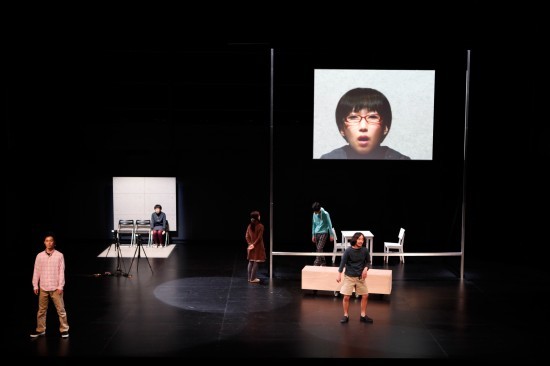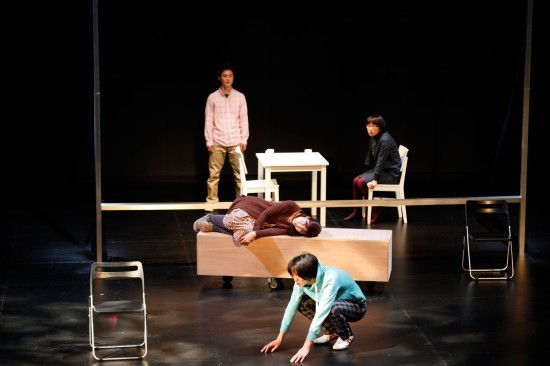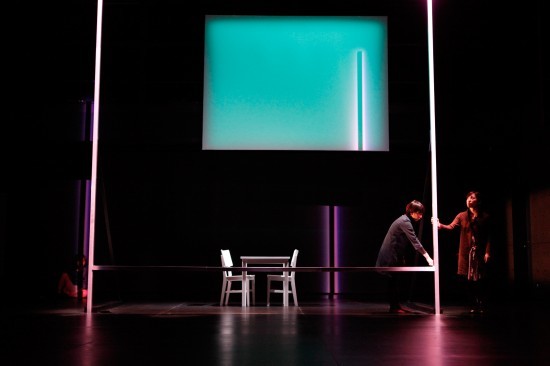The sublime and the everyday – Chelfitsch: The Sonic Life of a Giant Tortoise
 Chelfitsch – Performance still of The Sonic Life of a Giant Tortoise (2008) at Kanagawa Arts Theatre, February 1, 2011. Photo Kikuko Usuyama.
Chelfitsch – Performance still of The Sonic Life of a Giant Tortoise (2008) at Kanagawa Arts Theatre, February 1, 2011. Photo Kikuko Usuyama.When I tried searching on the Internet for “Art Sphere” I discovered there is no longer a theatre of that name: it is now called The Galaxy Theatre. In 2006 the management changed, and it is now apparently operated by a company affiliated with the mainstream talent agency Horipro. As I recall, the last time I set foot in this theatre was in 2005 when I attended a concert by the late composer Karlheinz Stockhausen. Stockhausen appeared on stage to thunderous applause, and there was one man in the front row lower balcony who continued shouting and clapping right to the end. It was the writer Masaya Nakahara. He clapped for so long that even Stockhausen noticed him, and for a moment the two looked at each other. For that brief moment, it was as if within that vast theatre a spotlight was focused on these two men, with the entire space around them blacked out. Of course the concert itself was also deeply moving, but personally I can never forget this scene in which the two figures came face-to-face, an encounter that was not so much historic as one that warped music history given that one of the figures was the direct artistic descendant of the other.
I’ve gone off on a tangent, but the reason I was searching for Art Sphere was that I recalled seeing at the same venue in 1992 a nearly five-hour long performance of the legendary Philip Glass/Robert Wilson opera Einstein on the Beach, which premiered in 1976. It was a repeat performance to mark the opening of the theater. I vaguely remember that the audience was free to enter and leave at will during the performance, and that the opera had already begun when the doors opened. Unfortunately I recall very little of the opera itself, although there was one scene I will never forget. This was a sequence in which for what seemed an eternity a white column of light rose very slowly upwards from the stage. Even now, I still remember faintly this one scene, which from time to time suddenly crosses my mind. This happened the other day, leading me to try to recall if I really did see this performance at such a theatre, which is why I suddenly got the urge to look it up.
 Chelfitsch – Performance still of The Sonic Life of a Giant Tortoise (2008) at Kanagawa Arts Theatre, February 1, 2011. Photo Kikuko Usuyama.
Chelfitsch – Performance still of The Sonic Life of a Giant Tortoise (2008) at Kanagawa Arts Theatre, February 1, 2011. Photo Kikuko Usuyama.But why did I recall Einstein on the Beach in the first place? This can only be due to the fact that a few days earlier I had seen a performance of Chelfitsch’s new work, The Sonic Life of a Giant Tortoise, at Kanagawa Arts Theatre in Yokohama, which also happened to be an inaugural performance. Now, several days later, I find myself trying to write about this performance, and looking back with all this in mind, I realize the thing etched in my memory more clearly than anything else was the “light experience” projected onto the stage. In the meantime, that memory of Einstein on the Beach came to the surface.
Although I haven’t seen all of Chelfitsch’s performances, of those I have seen this was the first in which the lighting left such a strong impression on me (although in their recent performances there seems to have been an emphasis on lighting). Previously, the most impressive element had been the way the complexities of the “everyday” we all live were brought to light by way of the movements of the performers on stage. In fact, the word “everyday” appeared over and over again in the simple pamphlet that was handed out as the audience entered the theatre, so this time I had this as a keyword in the back of my mind as I watched, although by the end of the performance I had completely forgotten about any such “words.” Although it’s difficult to explain, I didn’t feel as if I were watching a performance with a theme of some kind, although this is not to say it was like a dance in which the participants moved their bodies this way or that way. Perhaps it’s more accurate to describe it as taking one’s time gazing at a structure that incorporates movement, a part of which contains people. And among all this, the most impressive thing (from my own perspective, that is) was the treatment of space in relation to light.
Normally, lighting in the performing arts naturally takes on a secondary role of effectively picking out the subject or subjects of activity in the dance or play. If not, at the very most, it is no more than something integrated as a part of the backdrop or stage set. “No more than” may be an overstatement, but at the least it is difficult to imagine it playing a “leading role.” However, when I saw this performance by Chelfitsch I felt a major reversal was taking place. Rather than “lighting,” here “light” was transformed into various shades, colors and shapes and was enveloping the performers and filling space, almost as if it were in the leading role from start to finish. (One could refer to this as ambience created through the use of light, but this would be too consistent with the fact that the music that played during the performance was Brian Eno’s ambient music, so here I will go no further than noting this in passing.)
 Chelfitsch – Performance still of The Sonic Life of a Giant Tortoise (2008) at Kanagawa Arts Theatre, February 1, 2011. Photo Kikuko Usuyama.
Chelfitsch – Performance still of The Sonic Life of a Giant Tortoise (2008) at Kanagawa Arts Theatre, February 1, 2011. Photo Kikuko Usuyama.What I want to say (even leaving aside the fact that I end up looking at things this way because I’m an art critic) is that I felt this new work is more a sculptural artwork than an example of theatre. When you think about it, Einstein on the Beach itself was similar given its historical context, but Chelfitsch’s use of “light” seems to faithfully carry on into the present the tradition that in the art world is characterized by the shift from minimalism to post-minimalism, far more so than any recent example of “contemporary art,” for example.
Take, for example, Dan Flavin, famous for creating installations consisting solely of fluorescent light tubes lined up in rows or in other formations. It goes without saying that Flavin epitomizes minimalist art, but his innovations should probably be interpreted as an extension of the tendency observable in the work of Western artists from Vermeer through to the Impressionists to portray light itself rather than physical subjects. Instead of using paint to depict light, Flavin used light itself to create his artwork. In doing so, the important thing was that it was no longer necessary, as it is in painting, for the work to be brought into prominence with lighting. The work itself is a light source, and because the space itself is filled with light, there is no longer any need for “lighting.” The spatial “master-servant relationship” between the artwork as an object and the lighting arrangement no longer exists. (The same thing can be said of James Turrell, but Dan Flavin’s use of light is more direct, more thorough in its rejection of emotion, and more coolheaded.)
In sum, in viewing this latest performance by Chelfitsch, I sensed what could best be described as a theatrical space in which “lighting” has ceased to exist. Instead of effectively picking out the performers, the light is autonomous of the space, and rather than the performers coming to the fore on account of the light, it is as if they are inevitably “in it.” This is probably not unrelated to the fact that when the H-shaped structure built at the front of the stage is lit and casts a shadow on the backdrop, the entire stage resembles one of Barnett Newman’s paintings with a vertical line, or “zip,” down the middle. Come to think of it, perhaps the giant column of light that appeared on stage in Einstein on the Beach whose image was seared into my memory was also a transformation and re-representation on stage of the context that has been present from Newman’s “zip” right through to Dan Flavin (ie, the elimination of the “theatricality” of theatre). In all of these examples, people seem to be the subject, yet one’s gaze is directed towards the expanse of space beyond. When all is said and done, is not Chelfitsch’s “now” heading in the direction of just such a theatre of dehumanism? To go as far as to use the word “everyday” in this context can only mean it is being used in a sense that goes beyond people’s “lives” to also include “the sublime” (Newman).
Chelfitsch: The Sonic Life of a Giant Tortoise
Written and directed by Toshiki Okada
Performed by: Taichi Yamagata, Shoko Matsumura, Tomomitsu Adachi, Riki Takeda, Yukiko Sasaki
Production Design: Torafu Architects
Lighting design: Tomomi Ohira
